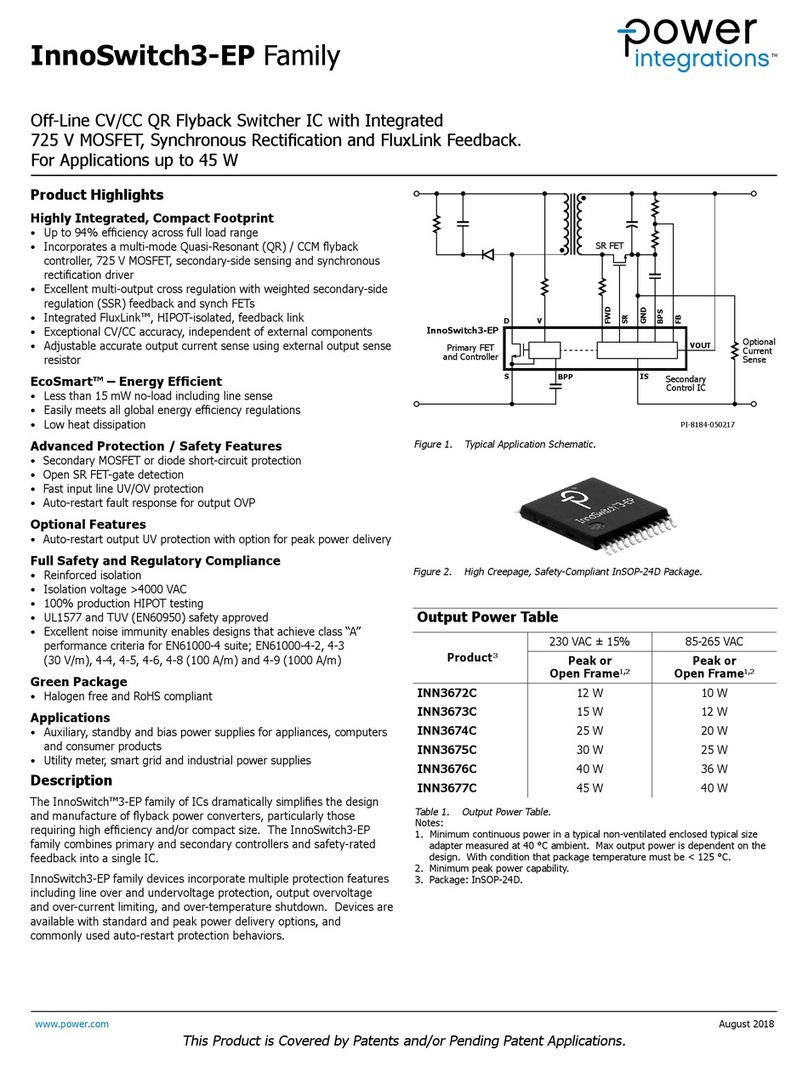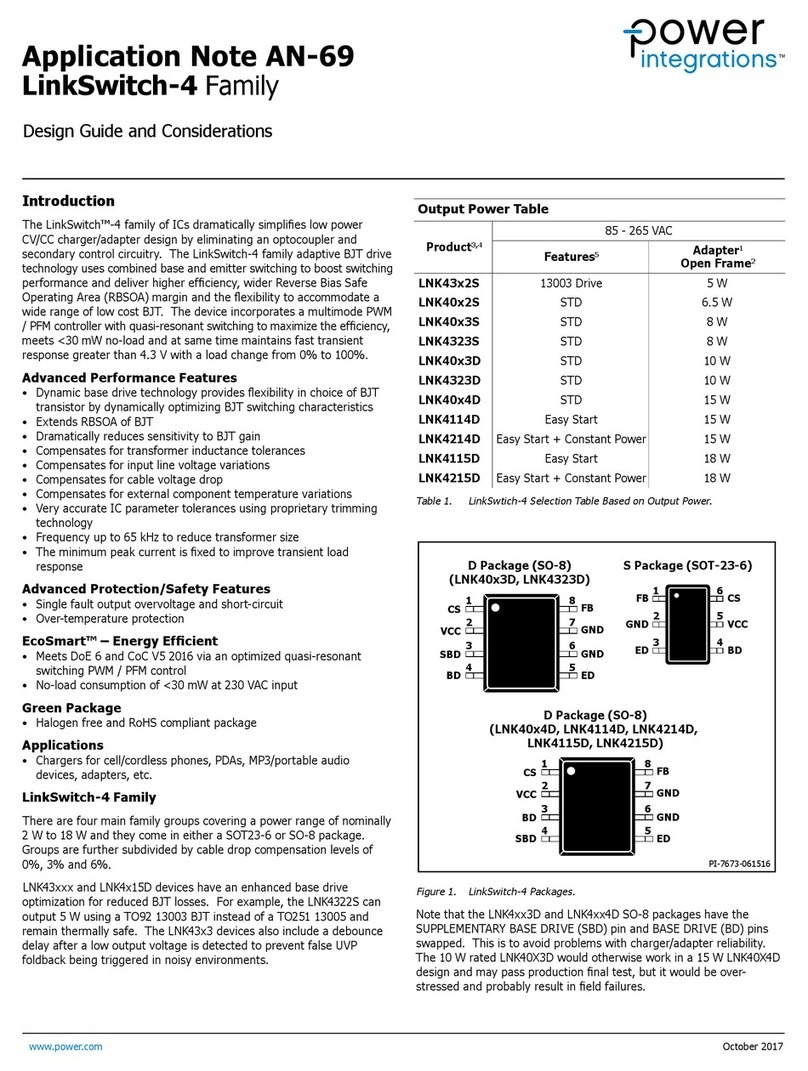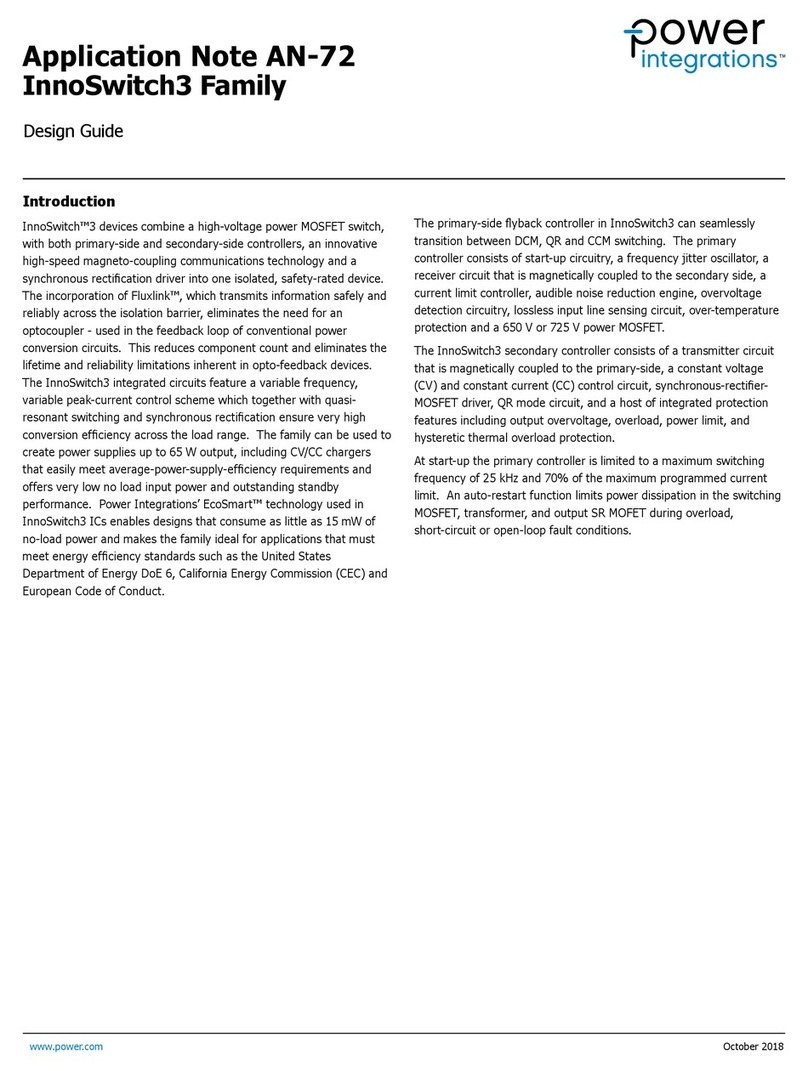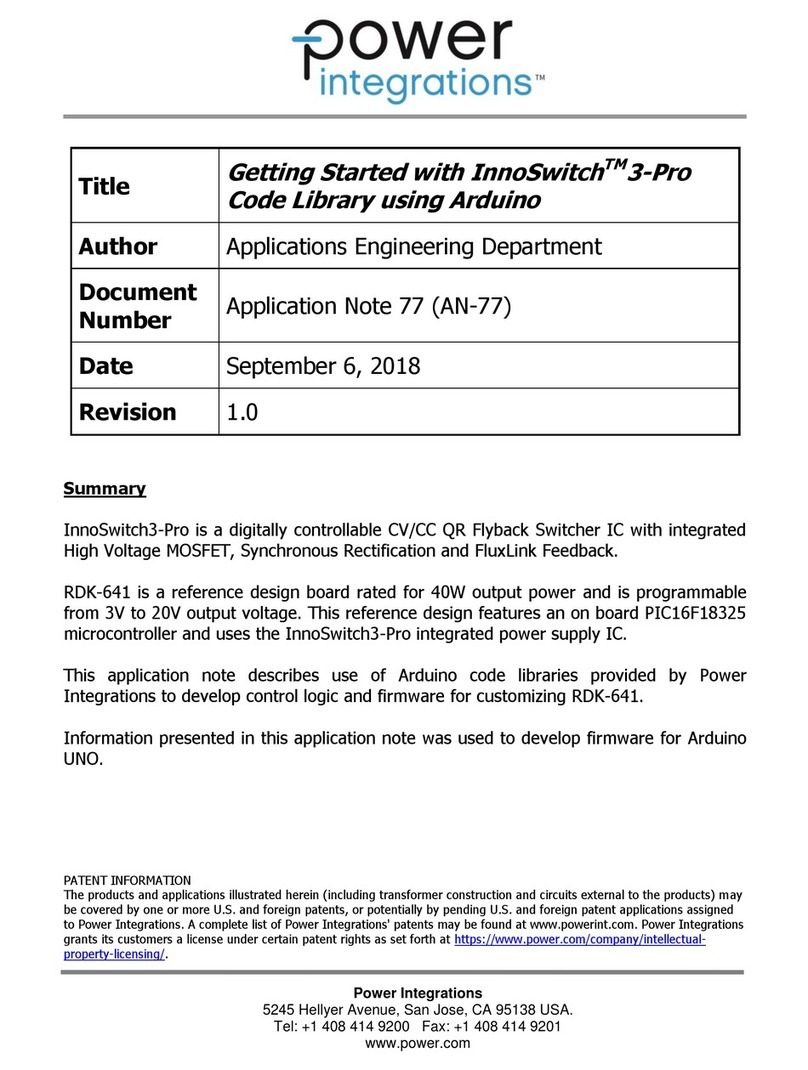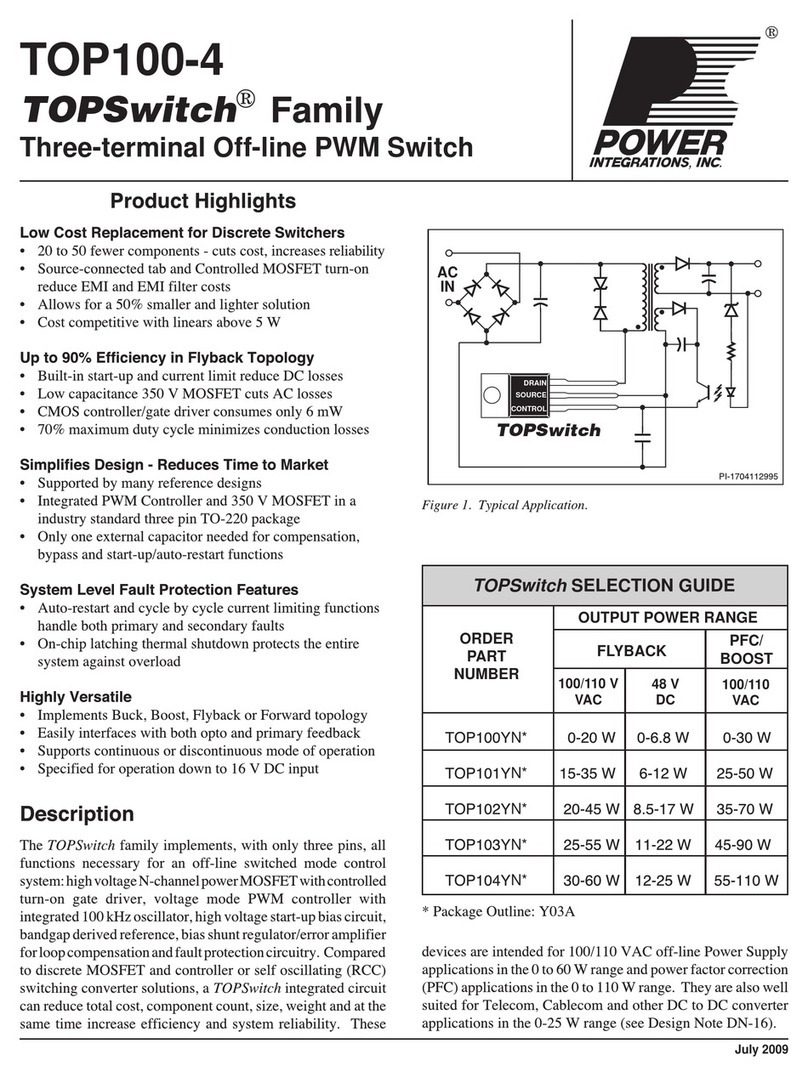
Rev. J 08/16
8
TOP252-262
www.power.com
4. Switching frequency of 132 kHz reduces the transformer size
with no noticeable impact on EMI.
5. Frequency jittering reduces EMI in the full frequency mode at
high load condition.
6. Hysteretic over-temperature shutdown ensures automatic
recovery from thermal fault. Large hysteresis prevents circuit
board overheating.
7. Packages with omitted pins and lead forming provide large
drain creepage distance.
8. Reduction of the auto-restart duty cycle and frequency to
improve the protection of the power supply and load during
open loop fault, short circuit, or loss of regulation.
9. Tighter tolerances on I2f power coefficient, current limit
reduction, PWM gain and thermal shutdown threshold.
The VOLTAGE-MONITOR (V) pin is usually used for line sensing
by connecting a 4 MW resistor from this pin to the rectified DC
high voltage bus to implement line overvoltage (OV), under-
voltage (UV) and dual-slope line feed-forward with DCMAX
reduction. In this mode, the value of the resistor determines the
OV/UV thresholds and the DCMAX is reduced linearly with a dual
slope to improve line ripple rejection. In addition, it also
provides another threshold to implement the latched and
hysteretic output overvoltage protection (OVP). The pin can
also be used as a remote ON/OFF using the IUV threshold.
The EXTERNAL CURRENT LIMIT (X) pin can be used to reduce
the current limit externally to a value close to the operating peak
current, by connecting the pin to SOURCE through a resistor.
This pin can also be used as a remote ON/OFF input.
For the P and G package the VOLTAGE-MONITOR and
EXTERNAL CURRENT LIMIT pin functions are combined on
one MULTI-FUNCTION (M) pin. However, some of the functions
become mutually exclusive.
The FREQUENCY (F) pin in the TOP254-258 Y and E/L packages
set the switching frequency in the full frequency PWM mode to
the default value of 132 kHz when connected to SOURCE pin. A
half frequency option of 66 kHz can be chosen by connecting
this pin to the CONTROL pin instead. Leaving this pin open is
not recommended. In the P, G and M packages and the
TOP259-261 Y packages, the frequency is set internally at
66 kHz in the full frequency PWM mode.
CONTROL (C) Pin Operation
The CONTROL pin is a low impedance node that is capable of
receiving a combined supply and feedback current. During
normal operation, a shunt regulator is used to separate the
feedback signal from the supply current. CONTROL pin voltage
VCis the supply voltage for the control circuitry including the
MOSFET gate driver. An external bypass capacitor closely
connected between the CONTROL and SOURCE pins is
required to supply the instantaneous gate drive current. The
total amount of capacitance connected to this pin also sets the
auto-restart timing as well as control loop compensation.
When rectified DC high voltage is applied to the DRAIN pin
during start-up, the MOSFET is initially off, and the CONTROL
pin capacitor is charged through a switched high voltage
current source connected internally between the DRAIN and
CONTROL pins. When the CONTROL pin voltage VCreaches
approximately 5.8 V, the control circuitry is activated and the
soft-start begins. The soft-start circuit gradually increases the
drain peak current and switching frequency from a low starting
value to the maximum drain peak current at the full frequency
over approximately 17 ms. If no external feedback/supply
current is fed into the CONTROL pin by the end of the soft-start,
the high voltage current source is turned off and the CONTROL
pin will start discharging in response to the supply current
drawn by the control circuitry. If the power supply is designed
properly, and no fault condition such as open loop or shorted
output exists, the feedback loop will close, providing external
CONTROL pin current, before the CONTROL pin voltage has
had a chance to discharge to the lower threshold voltage of
approximately 4.8 V (internal supply undervoltage lockout
threshold). When the externally fed current charges the
CONTROL pin to the shunt regulator voltage of 5.8 V, current in
excess of the consumption of the chip is shunted to SOURCE
through an NMOS current mirror as shown in Figure 3. The
output current of that NMOS current mirror controls the duty
cycle of the power MOSFET to provide closed loop regulation.
The shunt regulator has a finite low output impedance ZCthat
sets the gain of the error amplifier when used in a primary
feedback configuration. The dynamic impedance ZCof the
CONTROL pin together with the external CONTROL pin
capacitance sets the dominant pole for the control loop.
When a fault condition such as an open loop or shorted output
prevents the flow of an external current into the CONTROL pin,
the capacitor on the CONTROL pin discharges towards 4.8 V.
At 4.8 V, auto-restart is activated, which turns the output
MOSFET off and puts the control circuitry in a low current
standby mode. The high-voltage current source turns on and
charges the external capacitance again. A hysteretic internal
supply undervoltage comparator keeps VCwithin a window of
typically 4.8 V to 5.8 V by turning the high-voltage current
source on and off as shown in Figure 11. The auto-restart
circuit has a divide-by-sixteen counter, which prevents the
output MOSFET from turning on again until sixteen discharge/
charge cycles have elapsed. This is accomplished by enabling
the output MOSFET only when the divide-by-sixteen counter
reaches the full count (S15). The counter effectively limits
TOPSwitch-HX power dissipation by reducing the auto-restart
duty cycle to typically 2%. Auto-restart mode continues until
output voltage regulation is again achieved through closure of
the feedback loop.
Oscillator and Switching Frequency
The internal oscillator linearly charges and discharges an
internal capacitance between two voltage levels to create a
triangular waveform for the timing of the pulse width modulator.
This oscillator sets the pulse width modulator/current limit latch
at the beginning of each cycle.
The nominal full switching frequency of 132 kHz was chosen to
minimize transformer size while keeping the fundamental EMI
frequency below 150 kHz. The FREQUENCY pin (available only
in TOP254-258 Y and E, L packages), when shorted to the
CONTROL pin, lowers the full switching frequency to 66 kHz

